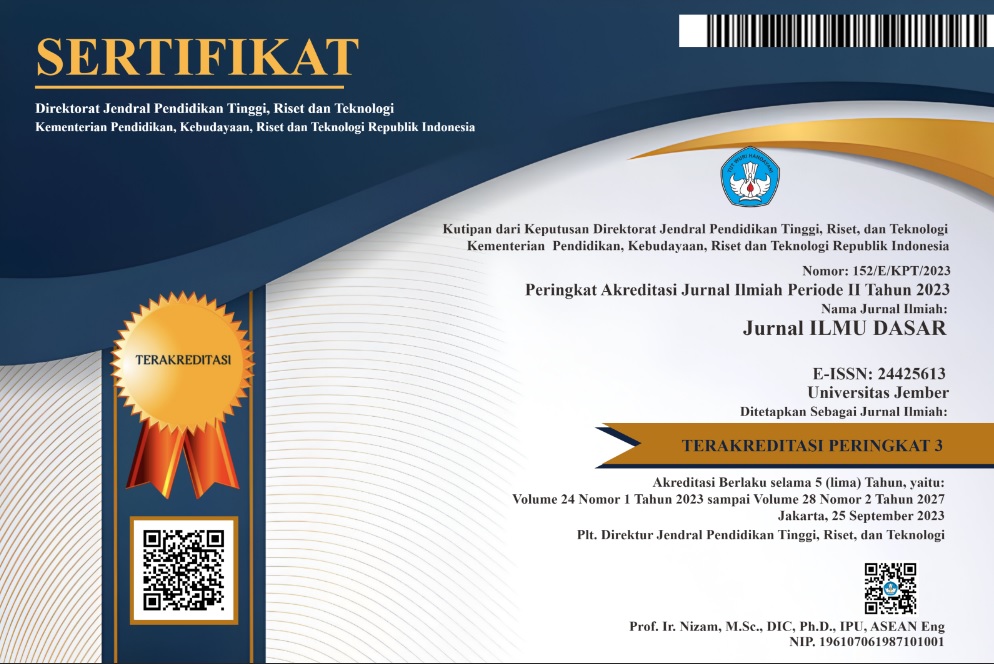Fluctuation of Insect Population on Rice Field in Pangkalan Sub-district Karawang Regency: Indicator for Environmental Health
DOI:
https://doi.org/10.19184/jid.v20i1.7150Abstract
Pangkalan Sub-district is a forest edge area in Karawang that is rich in flora and fauna that has not been much identified. Because of its unique location that is bordered by primary forest, agricultural ecosystems in the area will not be separated from the influence of the surrounding forest. So, it is necessary to know more about the diversity and abundance of insects in the wetland rice ecosystems.The research was conducted in Pangkalan sub-district, Karawang regency. The size of each plot was 5 x 5 m (25 m2) and each treatment was repeated five times. Treatments carried out with integrated pest management (IPM), chemical pest management techniques (P-K), and Mixed Pest Management (P-C). Insect retrieval technique using sweep net method, yellow pan trap, and direct observation. The abundance of arthropod species found in 12 Orders consist of: Thysanoptera Order (2.4%), Orthoptera (0.5%), Odonata (1.4%), Mantodea (0%), Lepidoptera (8.7%), Hymenoptera (2.4%), Hemiptera (61.8%), Diptera (2.4%), Derma ptera (3.6%), Coleoptera (8.3%), Architaenioglossa (0.5%), and Aranea (8.0%). Based on the species richness, it was found that the orders of Diptera (25 species), Coleoptera (19 species), and Hymenoptera (18 species) showed higher numbers than other orders. The H 'diversity index in this study ranged from 1.99 to 2.45, the D index ranged from 0.73 to 0.88, and the E index ranged from 0.5 to 0.7. Overall the P-K plots showed a lower population abundance compared to IPM and P-C plots. Intense and scheduled spraying of insecticides on P-K plots causes a lower population abundance, which makes the diversity become low.
Keywords: Rice pests, diversity of insects, natural enemies, pesticides, integrated pest control (IPM)
Downloads
References
Altieri MA. 1999. The ecological role of biodiversity in agroecosystems. Agricult Ecosys Environ 74:19-31.
Crowder DW, Northfield TD, Strand MR, Snyder WE. 2010. Organic Agriculture.
[CSIRO] Commonwealth Scientific and Industrial Research Organization. 1996. The Insect of Australia: A Teexbook for Students and Research Workers. Second edition. Melbourne University Press. Victoria.
Daly HV, Doyen JT, Ehrlich PR. 1978. Introduction to Insect Biology and Diversity. International Student Edition. Tokyo: Mc. Graw-Hill, Kogakusha.
Downie IS, Wilson WI, Abernethy VJ, McCracken DI, Foster GN, Ribera I, Murphy KJ, Waterhouse A. 1999. The impact of different agricultural land-uses on epigeal spider diversity in Scotland. J Insect Conserv,3:273-286.
Goulet H, Huber JT. 1993. Hymenoptera of the World. An Identification Guide to Families. Ottawa (CA): Agriculture Canada.
Halloway JD, Stork NE. 1991. The dimensions of biodiversity: the use of invertebrates as indicators of human impact. Di dalam: Hawksworth DL (ed). The Biodiversity of Microorganism and Invertebrates: Its Role in Sustainable Agriculture.United Kingdom: CAB International, Wallingford.
Janzen DH. 1987. Insect diversity of a Costa Rican dry forest: why keep it, and how?. Bio J Linnean Soci. 30:343-356.
Kirk-Spriggs AH.1990. Preliminary studies of rice pests and some of their natural enemies in the Dumoga valley, Sulawesi Utara, Indonesia. J Rain Forest Insects of Wallacea. 30:319-28.
Mahrub, E. 1998. Struktur Komunitas Artropoda Pada Ekosistem Padi Tampa Perlakuan Pestisida= Arthropod Community Structure In Rice Ecosystem Without Insecticide Treatment. Jurnal Perlindungan Tanaman Indonesia (Indonesian, Journal of Plant Protection), 4
McAlpine JF. 1987. Manual of Nearctic Diptera Volume 2. Ottawa (CA): Research Branch Agriculture Canada.
McLaughlin A, Mineau P. 1995. The impact of agricultural practises on biodiversity. Agricult Ecosys Environ 55:201-212.
Ovawanda EA, Witjaksono W, Trisyono YA. 2017. Insect Biodiversity in Organic and Non-Organic Rice Ecosystem in The District of Bantul. Jurnal Perlindungan Tanaman Indonesia. 2017 Jan 1:15-21.
Peck SL, McQuaid B, Campbell CL. 1998. Using ant species (Hymenoptera: Formicidae) as a biological indicator of agroecosystem condition. J Entomol Soci America. 27:1102-1110.
Rizali A. Buchori D, Triwidodo H. 2002. Insect diversity at the forest margin-ricefiels interface: indicator for health
ecosystem. Hayati. 9(2):41-48.
Samways MJ. 1994. Insect Conservation Biology. New York: Chapman & Hall.
Settle WH, Ariawan H, Astuti ET, Cahyana W, Hakim AL, Hindayana D, Lestari AS. 1996. Managing tropical rice pests through conservation of generalist natural enemies and alternative prey. Ecology. 1,77(7):1975-88.
Speight MR, Hunter MD, Watt AD. 2008. Ecology of Insects: Concepts and Applications. Oxford (UK): Blackwell Science Ltd.
Strong DR, Lawton JH, Southwood R. 1984. Insects on Plants. Boston: Harvard Univ Pr.
Taichi T, Mohamed M. 2004. Identification Key to the Families in Diptera (Insecta). Universiti Malaysia Sabah: Japan International Cooperation Agency.








